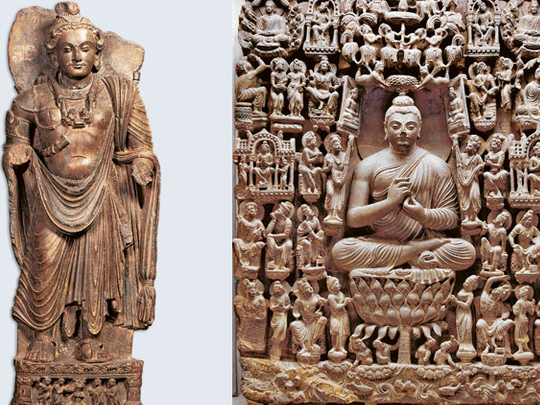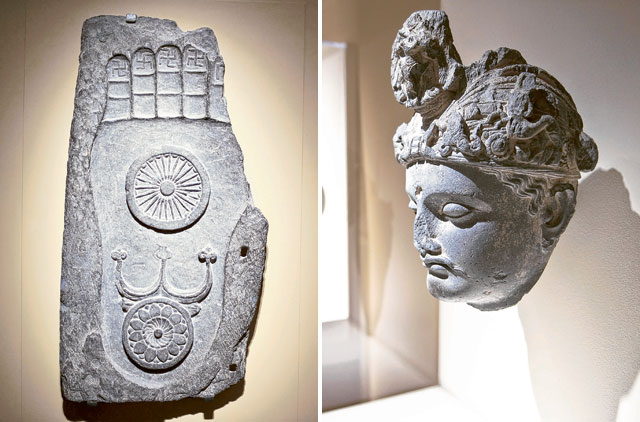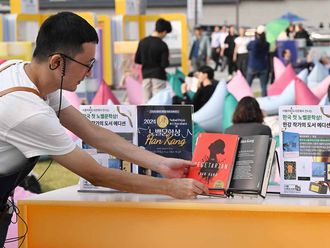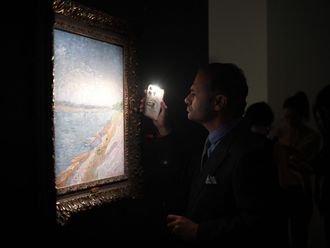
With an international image scarred by such unflattering euphemisms as the "epicentre of terrorism" and the "world's most dangerous place", Pakistan has been hitting the headlines in the international and particularly the American media for all the wrong reasons. An exhibition of rare Buddhist sculptures, architectural reliefs and works of gold and bronze from the Gandhara age reveal Pakistan's "softer side" and could be a step towards mitigating the negative attributes associated with the country. The exhibition, called The Buddhist Heritage of Pakistan: Art of Gandhara, opened on August 9 at the Asia Society Museum in New York.
Indeed, many Americans and Westerners who perceive Pakistan as a country facing disintegration because of religious extremism may be surprised to know that a rich and ancient culture with strong Hindu and Buddhist influences and fine touches of Greco-Roman and Scytho-Parthian traits flourished in what is today Pakistan.
"It is such a refreshing change to see people appreciate Pakistani culture even though it is not Islam we are talking about. Many people, including Pakistanis, believe that Pakistan has no other culture and religion besides Islam. This is a misconception and we need to highlight this ancient culture which would cast us in proper light in the international domain," says Mohsin Rahmat Khan, an American businessman originally from Karachi.
Public relations experts and spin doctors are confident that Pakistan could earn considerable goodwill if it shows religious pluralism. Indeed, the Gandhara exhibition is a small but important step to refurbish Pakistan's badly dented international image as a terrorist haven where violent crimes are perpetrated in the name of religion.
Gandhara history and culture
The Gandhara exhibition provides a deep insight into the region's ancient history. Gandhara — "Gandhar" in Sanskrit and Hindi — was the ancient kingdom concentrated in the vale of Peshawar, the Potohar plateau and on the Kabul River, sandwiched between what is today northern Pakistan and eastern Afghanistan.
The term "Hindu Shahi" was used by historian-writer Al Biruni to refer to the ruling Hindu dynasty that took over from the Turki-shahi and ruled the region during the period until the arrival of the Muslim conquerors in the 10th and the 11th centuries. The term "Gandhara" ceased to exist during the reign of Mahmoud of Ghazni.
The Gandhari people were settled since the Vedic times on the banks of the Kabul River down to its confluence with the Indus. The name "Gandhari" is mentioned in the Rig Veda and ancient inscriptions dating back to the Achaemenians of Persia.
The Behistun inscription listing the territories of King Darius (519BC) includes Gandhara along with Bactria and Thatagush. Located on the northern Trunk Road, Gandhara was a centre of international trade linking ancient Persia, India and Central Asia.
Gandhara is frequently mentioned in the epics Ramayana and Mahabharata. The main cities of Gandhara were Purushapura (Peshawar), Takshashila (Taxila) and Pushkalavati. Taxila was an important centre of learning from the 5th to the 2nd century BC. In 327BC Alexander the Great conquered Gandhara and the Indian satraps (provincial governors) of the Persian empire. Alexander's expeditions were recorded by his court historians and by Arrian (AD175) in his Anabasis and by other chroniclers many centuries later.
Chandragupta, the founder of the Mauryan dynasty, is said to have lived in Taxila. Gandhara remained part of the Mauryan empire for about a century and a half.
Ashoka, Chandragupta's grandson, started his career from Gandhara as a governor. After converting to Buddhism, he promoted the religion in his empire and built many stupas (Buddhist commemorative monuments housing sacred Buddhist relics associated with the Buddha or other saintly persons) in Gandhara.
The empire's decline heralded the advent of the Greco-Bactrian rule. Around 185BC, Demetrius conquered Gandhara. Factional wars resulted in Gandhara's independence from Bactria and the formation of an Indo-Greek kingdom. Menander, its most famous king, became a Buddhist.
Mahayana Buddhism flourished in Gandhara and Buddha was represented in human form; new stupas were built and huge Buddha statues were built in monasteries and carved into hillsides.
However, Buddhism suffered a setback with the conquest of Gandhara around 450 by the Hephthalite Huns who promoted Hinduism at the expense of the Gandharan civilisation.
Visiting Chinese Buddhist pilgrims have chronicled the decline of Buddhism and the rise of Hinduism in Gandhara. Fax-Xian recorded in 400 that Buddhism was flourishing but Xuan-Zang, who visited India around 644, found Buddhism on the wane and Hinduism on the ascent in Gandhara.
Rare opportunity
The Gandharan exhibition in New York has 70 rare artefacts on display. Although most have been loaned by the National Museum in Karachi and the Lahore Museum in Lahore, comparative Eastern and Western works illuminating the Greco-Roman and Scytho-Parthian influences on Gandharan art are included from the Metropolitan Museum of Art, Asia Society Museum and private collections in the United States.
"I hope this will not be the last time the exhibition is held," said Melissa Chiu, the Asia Society's museum director and vice-president for global art programmes. She emphasised that the exhibition afforded a rare opportunity for Americans, who seldom travel to Pakistan, to see these very rare objects, including the piece de resistance called Vision of a Buddha's Paradise.
The opening of the exhibition was well attended not only by Americans, Pakistanis and Indians but also by South East Asians, Japanese, Chinese and even Tibetan monks.
"I think the relevance of this art lies in the fact that it represents ancient crossroad cultures. We are now able to see something different from what Pakistan today reflects. In my experience, many Pakistanis thought it was important to demonstrate Pakistan's pluralistic character," Chiu told Weekend Review.
Meanwhile, there is a review under way in the entire discipline of art history. "Gandharan art has undergone a new appreciation now, with scholarship being developed around the idea that it is a global culture rather than a national culture," Chiu said. In recent years, according to Chiu, art historians have begun to argue that ours "is not the only period in which there was lots of cultural interchange and travel, but actually in the ancient world there were these moments. And so Gandharan art comes out as one of those."
The exhibition is structured into three thematic sections: the "Classical Connections" examines early connections with the classical world — the Greco-Roman and Hellenistic cultural influences — replete with motifs from Greek mythology and Western architectural elements such as Corinthian capitals; "Narratives and Architectural Context" examines the combination of local characteristics with elements derived from both Indian and Western precedents expressed in Gandharan architecture, notably the linear Vision of a Buddha's Paradise; and the third section, "Buddhas and Bodhisattvas", explores the diverse visual imagery of Buddhas and bodhisattvas in Gandhara. This section includes the Mohammad Nari stele, a visually stunning and complex stone carving representing Buddha's grand vision within his realm of influence.
Organising the Gandhara exhibition at the Asia Society was no easy task and, as some experts says, was a "rollercoaster". But Chiu's determination and enthusiasm to organise the exhibition did not go unrewarded.
"Against a backdrop of political turmoil and tensions in US-Pakistan relations, getting the artefacts has been an extraordinary achievement," Chiu explained. But she acknowledged that the Lahore Museum and the National Museum of Pakistan in Karachi and many individuals in the US and Pakistan were very supportive of the exhibition.
Pakistan's ambassador to the United Nations, Abdullah Hussain Haroon, is credited with facilitating the release of the artefacts from the museums in Pakistan to New York. "Yes, he was quite helpful in making the exhibition become a reality," says one New York-based art expert about Haroon.
At the start of the year, Chiu had an "uneasy feeling" that the exhibition's opening would not take place in March, as originally planned, when it emerged that the federal authorities in Islamabad had failed to notify the museums in Lahore and Karachi holding the exhibits that these were to be flown to New York. Pakistan's Ministry of Culture was not keen to allow the Gandhara artefacts to be flown out of the country again after holding exhibitions in Bonn, Zurich and Paris.
Things further escalated when the decision-making authority for loaning the artefacts to foreign institutions was transferred from the Culture Ministry to the local government of provinces where the museums are located.
Rising anti-Americanism in Pakistan, triggered first by the slaying of two Pakistanis by CIA contractor Raymond Davis, the killing of Osama Bin Laden and other tensions between the two sides very nearly killed the Gandhara project.
Indeed, there was the danger of the exhibition being again postponed or even cancelled. But Chiu was persistent; she visited Pakistan a couple of times and discussed the matter with a number of important personalities, including the Punjab governor Shahbaz Sharif. "I was helped by many friends along the way," she recalled.
"I persisted because this is a unique opportunity for us to show the cultural heritage of Pakistan at a time when US-Pakistan relations are probably at their worst," she said.
Chiu also pointed out that despite the images of present-day Pakistan as a place of violent extremism, the region had an ancient tradition of tolerance and pluralism as evidenced by the survival of "these spectacular examples of Gandharan art".
Manik Mehta is a commentator on Asian affairs.
The Buddhist Heritage of Pakistan: Art of Gandhara runs through October 30 at Asia Society in New York City.













